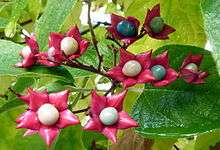Clerodendrum trichotomum
Clerodendrum trichotomum, the harlequin glorybower, glorytree or peanut butter tree, is a species of flowering plant in the family Lamiaceae. It is native to China, Korea, Taiwan, Japan, India, and the Philippines[1].[2]
| Clerodendrum trichotomum | |
|---|---|
 | |
| Scientific classification | |
| Kingdom: | Plantae |
| Clade: | Tracheophytes |
| Clade: | Angiosperms |
| Clade: | Eudicots |
| Clade: | Asterids |
| Order: | Lamiales |
| Family: | Lamiaceae |
| Genus: | Clerodendrum |
| Species: | C. trichotomum |
| Binomial name | |
| Clerodendrum trichotomum | |
It is a large deciduous shrub, growing 3–6 metres (10–20 ft) high. The leaves are ovate, up to 12 cm (5 in) long, soft and downy or hairy, producing a peanut odor when crushed. The fragrant flowers are borne on branching peduncles. They have white petals, held within a green calyx which turns red as the fruits ripen. The fruits (drupes) are white, changing to bright blue and eventually dark blue on maturity.[3] They contain the novel blue pigment trichotomine.[4]
It is cultivated for its fragrant flowers, autumn colour, and ornamental berries. It is hardy but requires a sheltered position. The variety C. trichotomum var. fargesii (Farges' harlequin glorybower) and the cultivar C. trichotomum var. fargesii 'Carnival'[5] have gained the Royal Horticultural Society's Award of Garden Merit.[6] (confirmed 2017).[7]
Etymology
Clerodendrum is derived from Greek, and means 'chance tree'.[8]
Trichotomum is also derived from Greek, and means 'three-forked' or 'triple-branched'.[8]
References
- Wearn, J.A.; Mabberley, D.J.; Bramley, G.L.C. (2019). Clerodendrum. Flora Malesiana. Series I - Seed Plants. Volume 23 - 2019. The Netherlands: Naturalis Biodiversity Center. p. 152. ISBN 978-90-6519-019-2.
- "Clerodendrum trichotomum". Germplasm Resources Information Network (GRIN). Agricultural Research Service (ARS), United States Department of Agriculture (USDA). Retrieved 23 January 2018.
- RHS A-Z Encyclopedia of Garden Plants. United Kingdom: Dorling Kindersley. 2008. p. 1136. ISBN 1405332964.
- Iwadare S, Shizuri Y, Yamada K, Hirata Y. Synthesis of trichotomine, a blue pigment obtained from Clerodendron trichotomum Thunb. Tetrahedron. 1978; 34(10):1457-1459. doi:10.1016/0040-4020(78)80166-5
- "Clerodendrum trichotomum var. fargesii 'Carnival'". RHS. Retrieved 12 April 2020.
- "Clerodendrum trichotomum var. fargesii". RHS. Retrieved 12 April 2020.
- "AGM Plants - Ornamental" (PDF). Royal Horticultural Society. July 2017. p. 22. Retrieved 24 January 2018.
- Gledhill, David (2008). "The Names of Plants". Cambridge University Press. ISBN 9780521866453 (hardback), ISBN 9780521685535 (paperback). p 111, 385
Further reading
| Wikimedia Commons has media related to Clerodendrum trichotomum. |
- Hillier, J. and A. J. Coombes. The Hillier Manual of Trees and Shrubs. David & Charles. 2007.